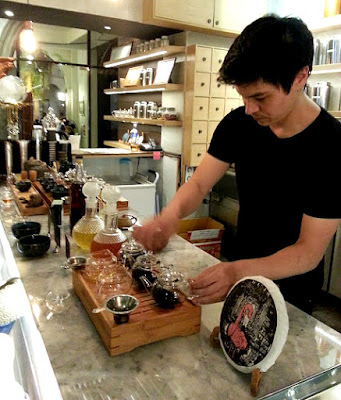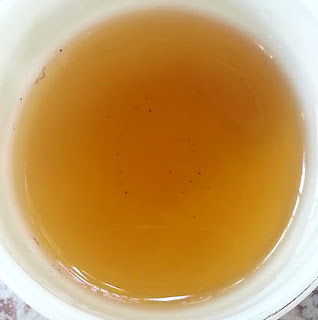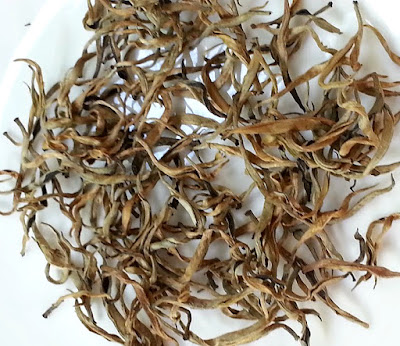 |
tea described as "silver" |
 |
silver tips version |
More teas from Nepal, trying out the last of those samples from the Himalayan Tea Shop.
As background, the business founder, Arpan Kambu, is a from a tea selling family there, a younger guy striking out on his own. The upside is that this is unique form of relatively direct sales, buying tea from an industry insider in a lesser developed tea source country. The downside is transparency; the details related to the teas and tea sourcing aren't clear, at least this early in the evolution of his business.
Of course most retail tea vendors don't give clear, explicit, complete details about tea sources, and anything less than that isn't as transparent as it would seem at a glance. One of these teas could use more branding for description purposes, just for saying what it is, but the main point is the tea, so onto more on the those.
Review
One is a silver tip style tea (I'm not sure how descriptive that is as a category; a buds-only white tea), the other made of buds and small leaves, described only as a silver tea. Typically silver tip teas are seen as a higher grade, harder to make, and more desirable, but the additional complexity of characteristics from including fine leaf matter can be a good thing. We'll see. I just read an interesting blog post claiming that both may not be a "true" white teas, from Tea For Me Please:
The Chinese definition of white tea stipulates that it must be grown in Fujian and made from the Da Bai variety of the tea plant. This definition was established at a time when China was the only producer of white tea. Now that we have white teas coming out of other regions like Ceylon and Darjeeling it becomes a bit of a gray area.
Either way, what's in a name, or in this case type-category.
Both teas are interesting, both quite different. It makes you wonder how closely the sources are related. Let's check on comparing appearance to another tea sold as a Shangrila White, reviewed in this post:
 |
Shangrila White (reviewed awhile back) |
Looks pretty similar, but who knows. It could be from a producer listed on this site, but even if so that information is not very descriptive. On to tasting.
The silver tip tea is earthier than teas made from only buds tend to be. It's light and subtle, kind of how that always goes, with nice sweetness, but the range can often be light hay, sunflower seed, and maybe a touch of floral, and this is different than that. Or actually that doesn't work so badly as a partial description to start, but there is more to it, so maybe the unconventional part is that complexity. Something like a trace of smoke comes across, nothing like the smoky-smoke in lapsang souchong, or the much stronger effect in some sheng pu'er, just a trace, one that flashes past in the first part of a second in tasting. After that other aspects fill out the range. I'll need another infusion round to describe those further.
The silver tea (what I'll call the buds and leaves style one, for lack of a better name) is not completely unrelated in final effect as that first buds-only tea, also in that similar white tea range, a bit of hay, bordering on sunflower seed, with some floral. But other aspects range that makes both teas complex is quite different. Different how, that's the harder part. The floral range could be different, and I'd not be able to pick that up, because it's a bit light and secondary in both. One might wonder: are these teas related, from the same producer? Hard to say, but they aren't really unrelated in character, and the variation could be coming from the input of the leaves, using different material. If it works out I'll do a follow-up post on more background from the provider.
The silver tea has a touch of complexity that comes across as savory. That's an odd description, since it might mean a lot to someone that already knows what I mean, but not others. It's not exactly like umami in Japanese green tea, but along that line. In this case it's more like sundried tomato than seaweed, as a savory element resembles in those teas.
Of course umami is the name for an actual taste-receptor based taste aspect, not a flavor, which is instead picked up by the receptors in the nasal passages. Umami is identified by the tongue, along with sweetness, bitterness, and sourness. I can't be sure how my body--through various receptors-- is processing this aspect and effect in this case; but with more training and experience I probably could. Based on having an unusual mouth feel maybe this is tongue related, an actual taste versus flavor. I won't do more tangent here on tasting but I will mention a great lead for that, the "Taste What You're Missing" video by Barb Stuckey on Youtube.
So the silver tip is brighter, complex, with some earthiness in addition to that light, wispy hay and floral range. The other silver tea feels completely different, with more depth of range, not so much brightness, and complexity that's not so simple to describe. I went longer on the next infusion; that might help.
 |
silver tea left, silver tips right |
The silver needle tea picks up plenty more complexity. Floral range elevates, and the feel thickens, that light earth range (hay, sunflower seed) is still present but it doesn't stand forward as much as the other aspects do. This is a pretty interesting silver needle style tea; lots going on, nothing like those where you struggle to pick out finer, wispy aspects and have to settle for appreciating the feel of the tea. Or brew it strong to get it to taste like anything, but even then some can still be a bit neutral when prepared that way. Sometimes subtlety works out well, in can lead to interesting effects, but that's a different story.
The sundried tomato element is nice when prepared stronger, sweet, complex, well-integrated with the rest of the range. That aspect could be interpreted in different ways, maybe as similar to the jack-o-lantern type of pumpkin (pumpkin types here are different, more like people tend to think of squash, although pumpkin is a squash, per my understanding). The hint of smoke is still only present in the initial taste, flashing across your palate in part of a second, then it's gone. That's quite different from the smoke effect in some sheng pu'er, which remains, maybe more on the aftertaste than actual taste, or at least both.
The other white (silver) is also a lot more intense, kind of a given, since it is brewed stronger. With some white teas aspects can stay vague and subtle even as intensity ramps up; they mostly just thicken, and go from light hay to heavier hay. There's nothing vague or subtle about this tea. Floral is also elevated, a similar range floral, which I'm not able to tie to a particular flower, or really even to express much range. It's sweet and rich but light, the kind of scent one might pick up in a wildflower meadow, I guess. A bit of earthiness and mineral range fills in a context, most pronounced as a subdued mineral base (like rocks--again I'll struggle with saying which rocks). The main difference in the teas is that stronger floral replacing all of the savory range in the other tea, and there being more mineral range.
There's a touch of earthiness in the buds and leaves version that could either be interpreted as interesting, positive complexity or as not being quite as clean in effect as the other tea. It seems a subjective call if it's positive or not, but to me it's clearly pleasant and enjoyable. It's a bit vague to describe easily, related to that stronger mineral range, but towards a woodiness, even though those are really different flavors scope (underlying earth and mineral ranges seem to somehow tie together, to express some related continuity, in this example). I think if this silver tip tea was more subtle, if there was less to it, I'd really like this buds and leaves version better, but as it is both offer plenty of complexity, and both are positive and interesting in character.
Another round of tasting could draw out a few more adjectives, and it might be clearer what I mean by these descriptions. I'm off to a swimming class soon so I'll need to rush this (my son's; I can swim just fine, although I'd stand out on a swim team for having bad form). I'll make a couple more comments about transition on a light infusion and close this.
 |
they swim; he's part of that splashing at the back |
That savory element picks up in the silver tip tea. What I mean might not be clear; it's a light, sweet, subtle, balanced white tea, with very clean flavors, nothing like a broth made from sundried tomatoes. I emphasize that element because it's unusual, and gives the tea a great positive complexity. Floral stands out the most, beyond that a light earthiness that could be hay or light wood, then below that the sundried tomato range. It's moving more to a light cooked sweet potato range in this infusion, transitioning, still not much like similar sweet-potato and yam taste range in Chinese black teas, but a little similar.
The buds and fine leaves tea is still plenty complex, still showing floral and light earth range too, with more mineral aspects grounding all that. To me it's clean in effect, and well balanced, and works really well. It's not as "bright" in effect as the buds only version, but the extra range is nice in a different way. That trace of mineral depth reminds me a little of drinking an aged (storage-abused?) white tea from a shop in NYC, a tea well darkened by poor large-jar storage conditions and aging. Of course it's only a hint of that range, a faint tie-in, and I actually don't mind the way that other vastly inferior tea comes across.
 |
"silver," buds and leaves version |
I never reviewed that tea, so I'll say a little more about it here, since it makes for an interesting tangent. A friend commented that adding a review in a review makes for something like a Russian doll effect, related to doing that in a Laos tea review, talking about making masala chai. If it were clearer what that white tea was I might have reviewed it; a tea from the New Kam Man shop in Chinatown, labeled only as white tea, as far as I recall. It included some buds and well-broken leaves. It was probably from China, but who knows.
The main question related to that tea, beyond type, is how long it had been in that jar to darken as it had, and how many times that jar had been opened, details I would never have learned even if I'd asked. It was interesting for how the white tea scope flavors had evolved, although of course I didn't know the starting point, what it had been like fresh, so there was some guesswork to that part. The short version: mineral tones ramped up, a lot. The tea tasted a lot like a limestone / flint range, much as I could identify that. It wasn't really "good," in the ordinary sense, but it was interesting, and complex, and not bad, so in a limited sense all that is good.
 |
silver tips versions; relatively large buds |
To summarize about these two teas: they're nice. They are not exactly like any other white teas I've tried, even different in character from other Nepal whites, to the extent I remember those. They work well with my preference for not being nearly as subtle as lots of white teas I've tried from lots of places. I guess that could be seen as a flaw related to other preference, for someone looking for subtlety, specific aspects range, and balance of factors other than flavors in white teas.
I haven't talked much about texture because the teas didn't seem particularly thick or thin to me, in the middle. It would still be possible to comment on how they feel anyway, related to impact to different parts of the mouth, but I didn't go there. I typically prefer straightforward teas where so much is going on with flavors range that the feel aspects can be largely set aside as an interesting complimentary component, and these teas worked out like that. For being no-name teas I found these both to be very impressive, on par with white teas from lots of other places and from different types of sources. Per my preferences they were better than most white teas I've tried, maybe even as good as any others.

































